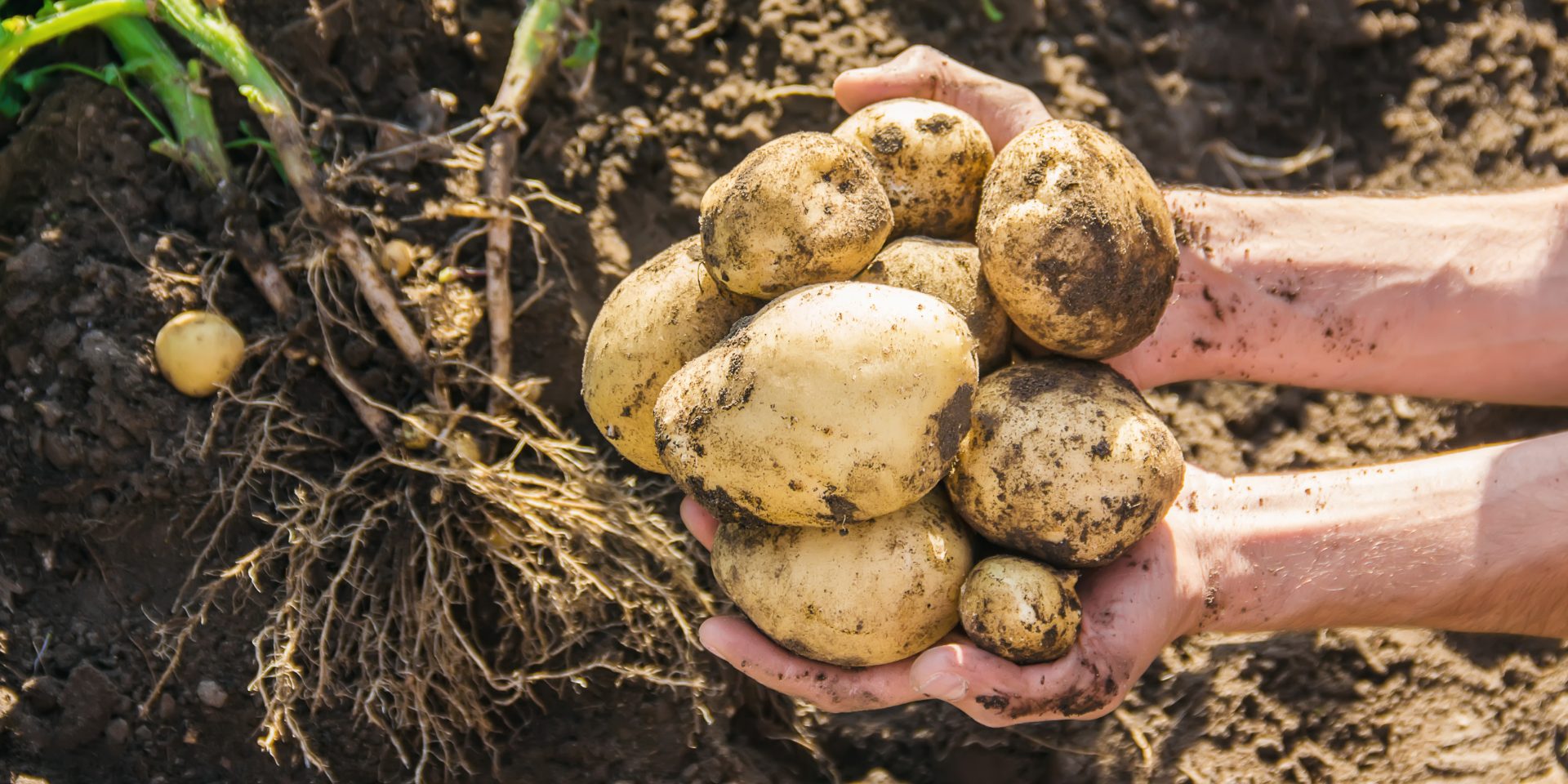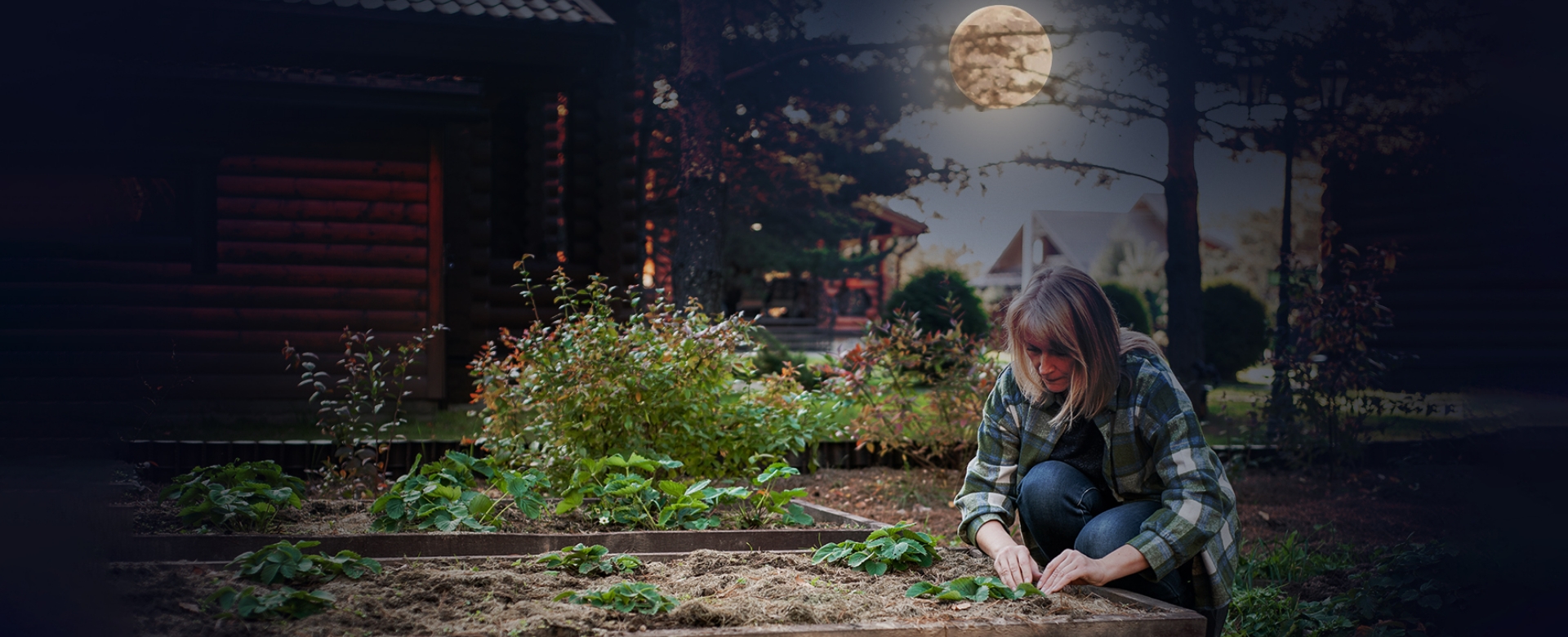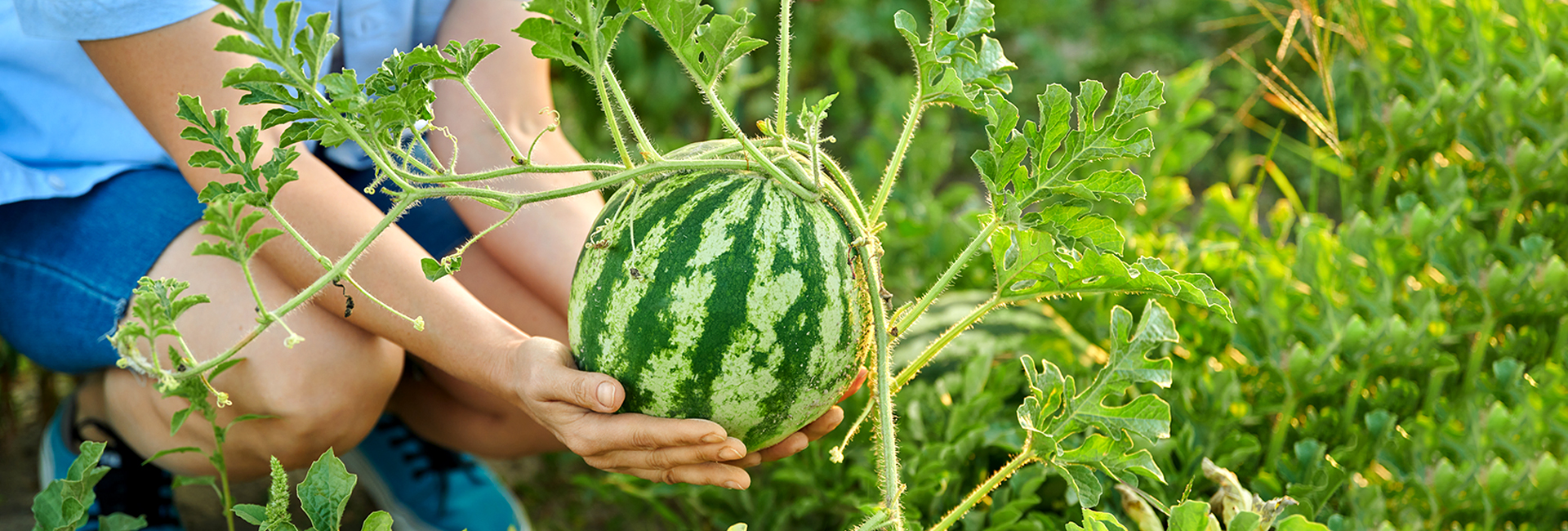Different potato varieties differ in the thickness of their skins. If potatoes are cured correctly, they develop thick skin. It is one of the best characteristics of potatoes when they are stored correctly.
The potato curing process is essential to get the most out of tubers. This process increases the lifespan of potatoes, prevents rotting, and improves the sweetness and flavor in the case of sweet potatoes. When you cure potatoes, it transforms your product by adjusting its humidity level, temperature, and light exposure.
Two factors play an essential role in the storage of potatoes: cool temperature and darkness. For the best results, ensure the temperature is not above 60-65°F or below 40°F. You can use mesh bags or containers to keep moisture at bay from potatoes and to avoid the rotting process.
What is Potato Curing?
Curing is a process in the food industry that involves storing potatoes after harvest. This process removes excess dirt and stores potatoes in aerated and dry conditions. It helps prevent loss from decay during their storage period, thereby improving their potential.
How to Cure Potatoes?
Cure potatoes by maintaining a temperature of 45-60°F and 80-90% humidity for 14 days. During the curing process, potatoes heal minor blemishes and nick. They are dried a bit to prevent rotting.
After curing potatoes, slowly decrease their storage temperature to about 40-46°F before use. Curing potatoes before storage reduces their chances of being damaged during storage.
To store potatoes for the winter season, you should cure them before storing them. It extends their shelf life and keeps them fresh for storage.
How to Cure Potatoes for Storage?
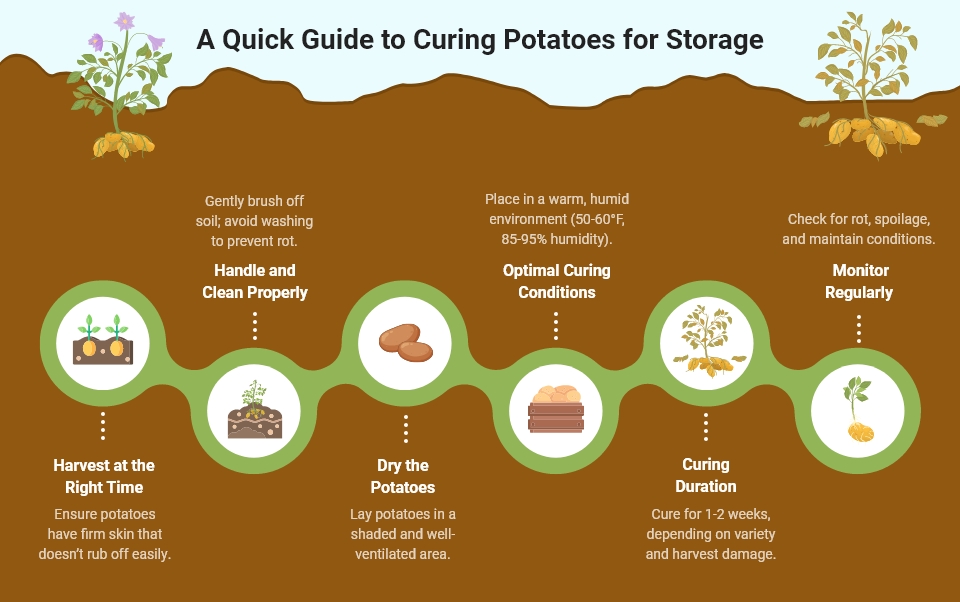
Curing potatoes for storage involves the following process:
Harvest at the Right Time
The curing process begins after the potatoes are harvested at a proper maturity stage. Harvest potatoes when their skin is firm and does not easily rub off. This time ensures sufficiently mature tubers to withstand the curing process and subsequent storage.
Proper Handling and Cleaning
After harvesting, gently handle the potatoes to minimize bruises and cuts. Carefully brush off any soil that clings to them. Avoid washing potatoes, as excess moisture can cause rot during the curing process.
Drying The Potatoes
After harvesting, potatoes require a brief drying period. Lay them in a single-layer shaded area with good air circulation. This curing step helps dry out any moisture from the surface and starts the skin toughening process. This helps prepare them for the curing environment.
Optimal Curing Conditions
To cure potatoes effectively, place them in a warm and humid environment. The ideal conditions for storing them are a temperature of 50-60°F and relative humidity of 85-95%. This temperature setting promotes the healing of minor damages and skin thickening, thereby reducing susceptibility to spoilage and disease.
Duration of Curing
Potatoes require about 1-2 weeks to cure based on their variety and the extent of damage caused during harvesting of potatoes grown in raised beds. Check regularly to ensure they remain in the best condition and monitor for any signs of rot or disease.
Monitor Regularly
You should monitor potatoes regularly to check for signs of spoilage or inadequate growing conditions throughout their curing period. You should regularly check the humidity, temperature and inspect the vegetable for soft spots or signs of decay. Adjust the growing environment as required to maintain ideal curing conditions.
By following the above-mentioned process, you can cure potatoes effectively, improving their shelf life, durability, and overall quality.
What are the methods of curing potatoes?
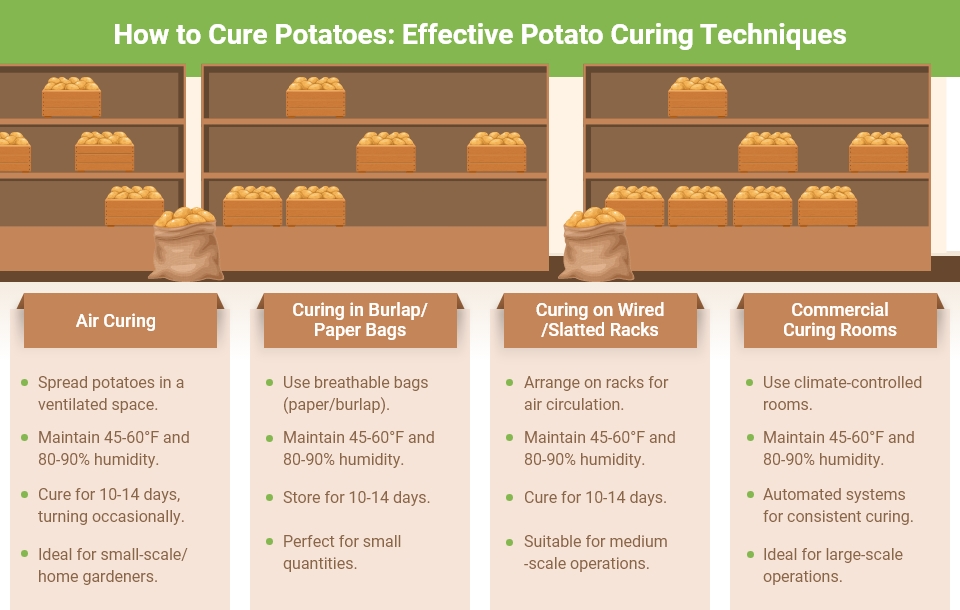
Curing potatoes forms an important step post-harvest. This step extends their shelf life and improves their quality. Different methods exist to cure potatoes effectively.
1. Air Curing
This traditional method involves spreading potatoes out in a well-ventilated space to allow them to heal naturally.
- Gently remove any loose soil from the potatoes without washing them.
- Place them in a single layer on a clean surface like a table, floor, or ground in a shaded area.
- Ensure the area has good air circulation and maintain a temperature between 45-60°F with 80-90% humidity.
- Allow them to cure for 10-14 days by turning them occasionally to promote even exposure to air.
This method is ideal for small-scale operations, situations, or home gardeners with minimal equipment.
2. Curing in Burlap or Paper Bags
Use breathable bags like paper or burlap for controlled curing while providing protection to potatoes from light and maintain humidity levels.
- Clean the potatoes by gently brushing off any remaining dirt.
- Place them loosely in paper bags or burlap sacks to ensure enough room for air to circulate them.
- Store these bags in a relaxed and humid environment with temperatures between 45-60°F and humidity of 80-90%.
- Keep the potatoes in the bags for about 10-14 days.
- This method is ideal for small quantities of potatoes, home storage, or where a simple yet controlled curing environment is desired.
3. Curing On Wired or Slatted Rack
Wired or slatted potato curing racks offer excellent air circulation, which helps curing potatoes evenly and prevents moisture buildup.
- Remove any loose soil from potatoes.
- Arrange them in a single layer on wired or slatted racks. Take care to ensure that the racks don’t touch each other.
- Place the racks in a cool area with a temperature between 45-60°F and humidity of 80-90%.
- Allow the potatoes to cure for 10-14 days.
- This curing method is most suitable for medium-scale operations and for farmers with available rack systems.
4. Commercial Curing Rooms
Commercial curing rooms can handle large quantities of potatoes and provide an ideal environment for potato curing. Temperatures and humidity are precisely controlled.
- Clean and sort potatoes before placing them in the curing room.
- Store potatoes in climate-controlled rooms with systems to maintain the desired temperature and humidity levels.
- The temperature of 45-60°F and humidity levels of 80-90% are maintained in the rooms.
- Automated systems constantly monitor and adjust conditions to ensure consistent curing.
- Potatoes are cured in these rooms for 10-14 days.
- This curing method is suitable for large-scale commercial operations, where consistent and controlled curing is required for quality and efficiency.
Why should we cure potatoes?
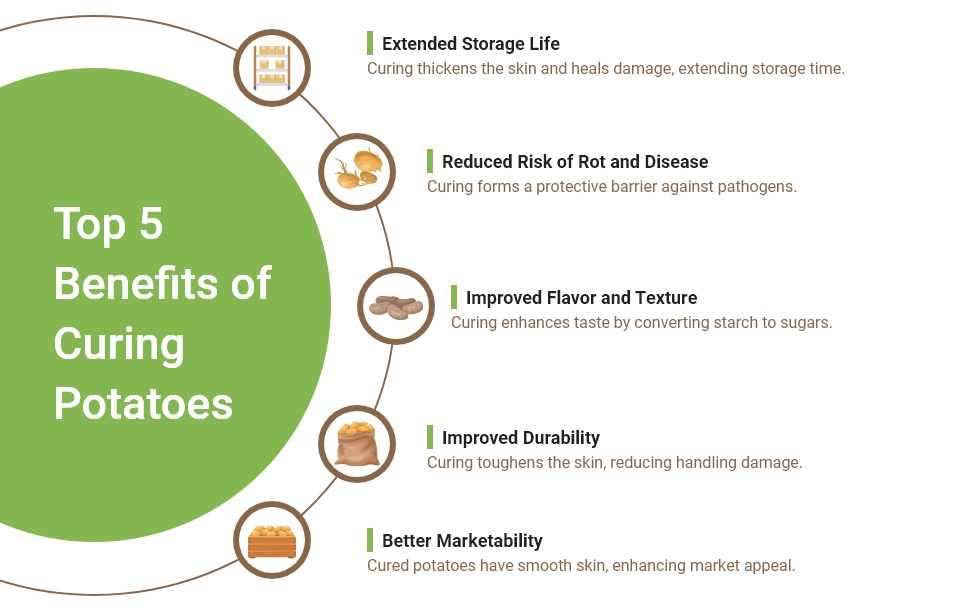
Curing potatoes causes the skin to thicken and slows the tubers’ respiratory rate, preparing them for storage. This essential post-harvest process improves potato quality and shelf life. Potatoes are stored in special conditions with high humidity and moderate temperature for a certain time to cure them.
Below are specific reasons as to why you should cure potatoes:
Extended Storage Life
One of the main benefits of curing potatoes is the extension of their storage life. Freshly harvested potatoes have a high moisture content and delicate skin, which makes them quickly susceptible to spoilage. Curing helps potatoes retain water by thickening and toughening their outer skin, which prevents dehydration.
Any cuts, nicks, or bruises incurred during harvesting start healing in the humid and warm curing environment. This process creates a barrier against moisture loss and microbial invasion, further delaying the process. These protective measures allow you to store cured potatoes for several months without affecting their quality.
Reduced Risk of Rot and Disease
Curing potatoes reduces the risk of rot and diseases in stored potatoes. The process encourages the formation of a thicker outer layer, which serves as a defense mechanism against pathogens. The outer skin of this vegetable keeps away bacterial and fungal infections, reducing the chances of rot.
The potato’s curing conditions stimulate its natural healing process, thereby closing off entry points for harmful microorganisms. By reducing rot and disease issues, cured ones are less likely to spoil, leading to higher yields and waste.
Improved Flavor and Texture
Curing potatoes enhances flavor and texture, making them more appealing to customers. During the curing process, the starch in the potato converts to sugars. This improves the taste and affects the texture, making the potatoes creamy and more desirable.
The healing process of potatoes ensures that the flesh remains firm and less prone to becoming mealy or gritty over time. These changes result in potatoes that are consistent, more flavorful, and attain desirable texture when cooked properly.
Improved Durability
Cured potatoes are durable and less prone to damage during handling and transportation. Curing toughens the skin, making the potatoes less susceptible to bruising. Their thick skin can withstand the rigors of handling and transport, reducing the incidences of cuts and bruises.
Better Marketability
Wholesalers, retailers, or consumers are attracted to properly cured potatoes. Cured potatoes appear appealing, with few blemishes, smooth, and tough skin.
Enhancing flavor, texture, and shelf life contributes to a higher perceived quality, making them more desirable in the market. Curing potatoes leads to better market prices and consumer satisfaction, which contributes to the profitability and sustainability of the potato farming business.
Conclusion
Curing potatoes is essential for extending their shelf life and maintaining quality. By allowing their skin to heal in a warm, dark, and humid environment, you can protect potatoes from rot and spoilage. This simple process ensures they stay fresh and delicious for months. This makes curing an important practice for both home gardeners and commercial growers. You should invest some time in curing your potatoes to reap the benefits even after harvest.
FAQs
You should cure potatoes in about 1-2 weeks.
No, you cannot cure potatoes in the fridge. Cure potatoes in a cool, dark, and well-ventilated space with temperatures around 45-60°F and 80-90% humidity. It allows the potato skins to thicken and toughen, which improves their storage quality and flavor.
If you don't cure your potatoes, their skin remains thin and susceptible to damage. It leads to quick spoilage and loss, which requires more optimal flavor development. The potatoes are more likely to develop green patches when exposed to light containing toxic solanine.
Let the potatoes sit indoors at 45-60°F for about two weeks. It will give their skin some time to harden and seal minor injuries.
You do not need to cure potatoes before eating them. Wash and cook potatoes immediately after harvesting them without curing. To store potatoes for a long time, cure them to increase their storage life and improve their flavor and texture over time.

